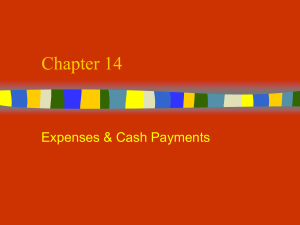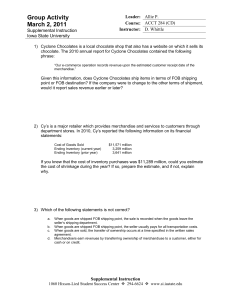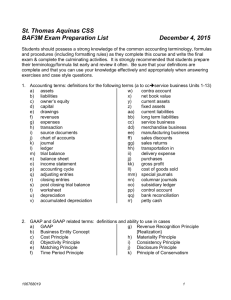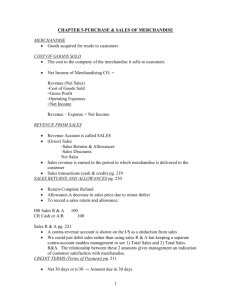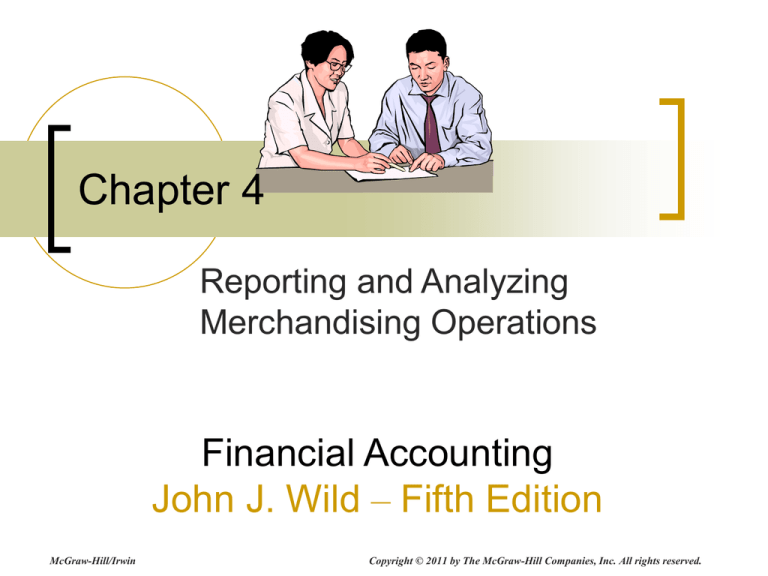
Chapter 4
Reporting and Analyzing
Merchandising Operations
Financial Accounting
John J. Wild – Fifth Edition
McGraw-Hill/Irwin
Copyright © 2011 by The McGraw-Hill Companies, Inc. All rights reserved.
Reporting Income for
a Merchandiser
C1
Merchandising companies sell products to earn revenue.
Examples: sporting goods, clothing, and auto parts stores
Net
sales
Minus
Cost of Equals
goods sold
Gross
profit
Minus
Expenses
Equals
Net
income
Merchandising Company
Income Statement
For Year Ended December 31, 2009
Net sales
Cost of goods sold
Gross profit
Operating expenses
Net income
$ 150,000
80,000
$
70,000
46,500
$
23,500
4-2
C3
Inventory Systems
Beginning
inventory
+
Net
purchases
= Merchandise
available for sale
Ending inventory
+
Cost of goods
sold
4-3
P1
Trade Discounts
Used by manufacturers and wholesalers
to offer better prices for greater
quantities purchased.
Example
Matrix, Inc. offers a 30% trade
discount on orders of 1,000
units or more of their popular
product Racer. Each
Racer has a list price of $5.25.
Quantity sold
Price per unit
Total
Less 30% discount
Invoice price
1,000
$ 5.25
5,250
(1,575)
$ 3,675
4-4
P1
Purchase Discounts
A deduction from the invoice price granted to induce
early payment of the amount due.
Terms
Discount Period
Credit
Period
Time
Due
Date of
Invoice
Due: Invoice
price minus
discount
Due: Full Invoice Price
4-5
P1
Purchase Discounts
2/10,n/30
Discount
Percent
Number of
Days
Discount Is
Available
Otherwise,
Net (or All)
Is Due in 30
Days
Credit
Period
4-6
P1
When Discount is Not Taken
If we fail to take a 2/10, n/30
discount, is it really expensive?
365 days ÷ 20 days × 2% = 36.5% annual rate
Days
in a
year
Number
of additional
days before
payment
Percent
paid to
keep
money
4-7
P1
Purchase Returns and Allowances
Purchase returns . . .
refer to merchandise a buyer acquires but then
returns to the seller.
Purchase allowance . . .
is a reduction in the cost of defective or
unacceptable merchandise that a buyer
acquires.
4-8
P1
Cost of Merchandise Purchased
Matrix, Inc.
Itemized Cost of Merchandise Purchases
For Year Ended May 31, 2009
Invoice cost of merchandise purchases
$ 692,500
Less:
Purchase discounts
(10,388)
Purchase returns and allowances
(4,275)
Add:
Cost of transportation-in
4,895
Total cost of merchandise purchases
$ 682,732
4-9
P2
Accounting for Merchandise Sales
Matrix, Inc.
Computation of Gross Profit
For Year Ended May 31, 2009
Sales
Less:
Sales discounts
Sales returns and allowances
Net sales
Cost of goods sold
Gross profit
$ 2,451,000
$ 29,412
18,500
47,912
$ 2,403,088
(1,928,600)
$
474,488
Sales discounts and returns and allowances are contra revenue accounts.
4-10
P4
Multiple-Step Income Statement
Barton Company
Income Statement
For Year Ended December 31, 2009
Sales
Less: Sales discounts
Sales returns
Net sales
Cost of goods sold
Gross profit
Operating expenses:
Selling expenses:
Salaries expense
$ 29,600
Advertising expense
13,300
General and administrative expenses:
Adm. salaries expense
$ 18,200
Insurance expense
1,200
Rent expense
8,100
Supplies expense
1,000
Total operating expenses
Net income
$ 323,800
$
$
4,300
2,000
6,300
$ 317,500
233,200
$ 84,300
42,900
28,500
71,400
$ 12,900
4-11
P4
Single-Step Income Statement
Barton Company
Income Statement
For Year Ended December 31, 2009
Net sales
Cost of goods sold
Operating expenses
Total expense
Net income
$ 317,500
$ 233,200
71,400
304,600
$ 12,900
4-12
P4
Balance Sheet
Barton Company
Balance Sheet
December 31, 2009
Assets:
Cash
$
7,700
Accounts receivable
11,200
Merchandise inventory
14,300
Supplies
1,300
Equipment
41,200
Accum. depr.- Equip.
(7,000)
Total Assets
Liabilities
Accounts payable
Salaries payable
Total Liabilities
Equity
Common Stock
Retained Earnings
Total Liabilities
Total Liabilities & Equity
$
68,700
16,400
1,000
17,400
$
$
42,400
8,900
51,300
68,700
4-13
A1
Acid-Test Ratio
Acid-test
=
ratio
Acid-test
=
ratio
Quick assets
Current liabilities
Cash + S/T investments + receivables
Current liabilities
A common rule of thumb is the acid-test ratio should
have a value of at least 1.0 to conclude a company is
unlikely to face liquidity problems in the near future.
4-14
Gross Margin Ratio
A2
Gross
margin =
ratio
Net sales - cost of goods sold
Net sales
Percentage of dollar sales available to
cover expenses and provide a profit.
4-15
End of Chapter 4
4-16

